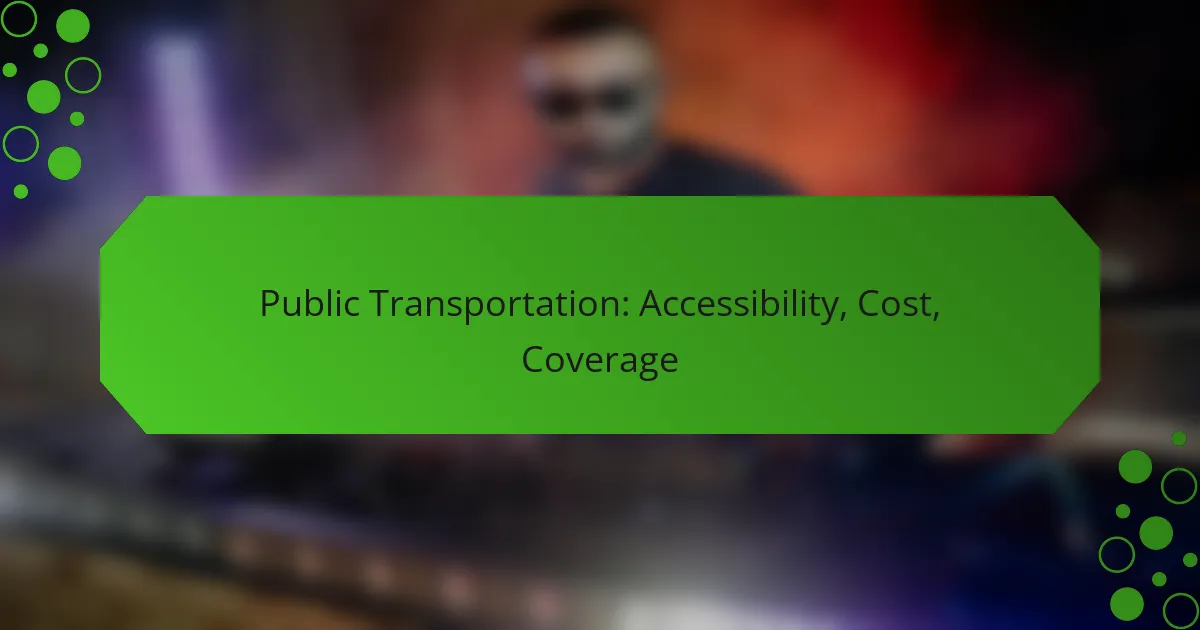Public transportation plays a crucial role in ensuring mobility for all, particularly through accessible options like wheelchair-friendly buses and paratransit services. The cost of these services can vary widely depending on the location and type of transport, while coverage is often more comprehensive in urban areas compared to suburban regions. Understanding these factors is essential for making informed travel choices.
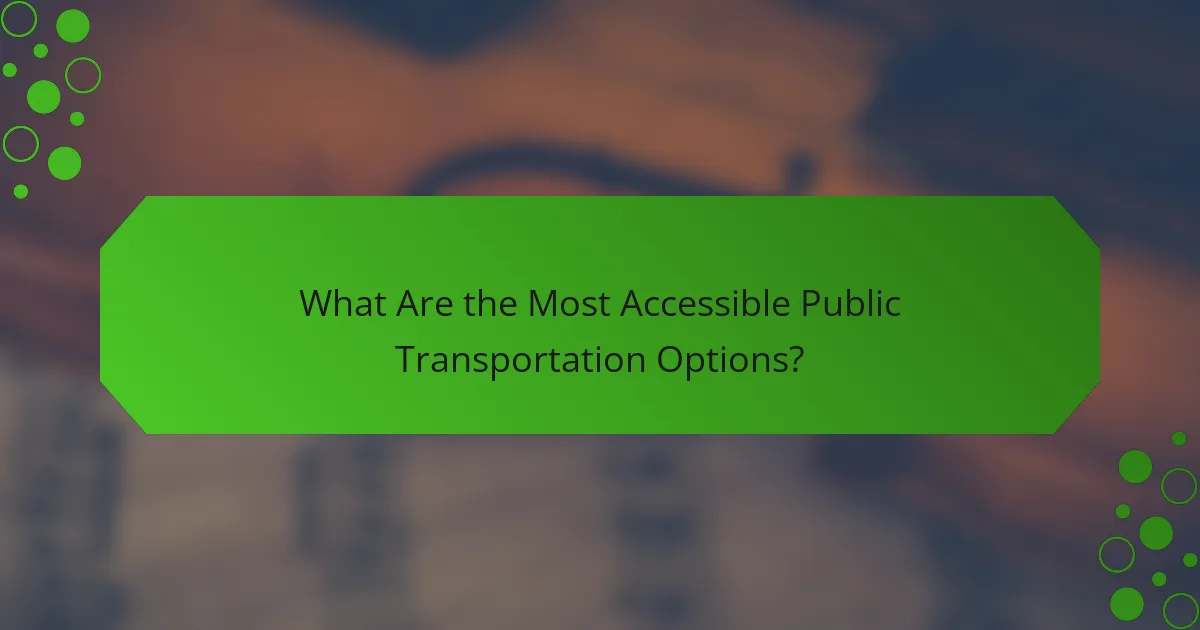
What Are the Most Accessible Public Transportation Options?
The most accessible public transportation options include wheelchair-accessible buses, accessible subway systems, paratransit services, and rideshare services with accessibility features. These options are designed to accommodate individuals with mobility challenges, ensuring they can travel safely and efficiently.
Wheelchair-accessible buses
Wheelchair-accessible buses are equipped with ramps or lifts to assist passengers with mobility devices. Most urban transit systems in the U.S. and Europe are required to have a certain percentage of their fleet accessible, often around 100% in major cities. Riders should check local transit websites for specific routes and schedules that feature these accessible buses.
When using these buses, it is advisable to arrive early to ensure you have enough time to board. Some systems may require advance notice for assistance, so contacting the transit authority beforehand can help avoid delays.
Accessible subway systems
Accessible subway systems feature elevators, ramps, and tactile guidance for visually impaired passengers. Many major cities, including New York and London, have made significant strides in improving accessibility, but coverage can vary widely. Check the subway map for accessibility icons that indicate which stations are equipped for wheelchair access.
Be aware that not all subway lines may be fully accessible, so planning your route in advance is essential. Some systems offer apps that provide real-time updates on elevator status, which can be particularly useful for travelers with disabilities.
Paratransit services
Paratransit services provide door-to-door transportation for individuals who cannot use regular public transit due to disabilities. These services often require advance booking and may have specific eligibility criteria, such as certification of disability. Costs can vary, typically ranging from a few dollars to the price of a standard fare.
To utilize paratransit, familiarize yourself with the application process in your area, as it may involve submitting medical documentation. Always book your ride ahead of time to ensure availability and confirm the exact fare before your trip.
Rideshare accessibility features
Many rideshare companies now offer vehicles equipped with accessibility features, such as wheelchair ramps and spacious interiors. Services like Uber and Lyft have options specifically designed for riders with disabilities, though availability may differ by location. Users can select these options through the app when requesting a ride.
Before booking, check the app for vehicle specifications to ensure it meets your needs. Additionally, consider reaching out to the driver upon arrival to confirm that the vehicle is equipped as expected, which can help avoid any last-minute issues.
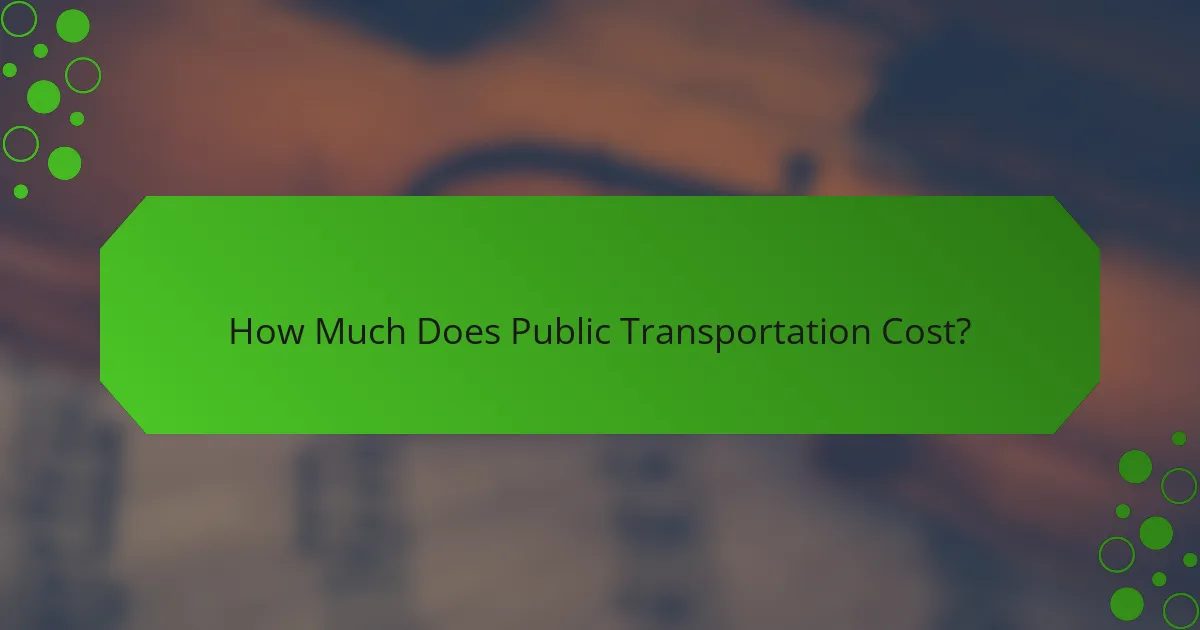
How Much Does Public Transportation Cost?
The cost of public transportation varies significantly based on location, type of service, and fare structure. Generally, fares can range from a couple of dollars for a single ride to higher amounts for specialized services or longer distances.
Average fare prices
Average fare prices for public transportation typically fall between $1 and $3 for a single trip in urban areas. Some cities may have higher fares for express services or premium routes. It’s advisable to check local transit authority websites for the most accurate and current fare information.
Discounts for seniors and students
Many public transportation systems offer discounts for seniors and students, often reducing fares by 50% or more. Eligibility for these discounts usually requires valid identification, such as a student ID or a senior citizen card. Always inquire about available discounts when purchasing tickets or passes.
Monthly passes vs. single tickets
Choosing between monthly passes and single tickets depends on your travel frequency. Monthly passes can save money for those who use public transport regularly, often costing less than the equivalent of multiple single fares. For occasional users, single tickets may be more economical, but consider the potential savings of a pass if you plan to travel frequently within the month.
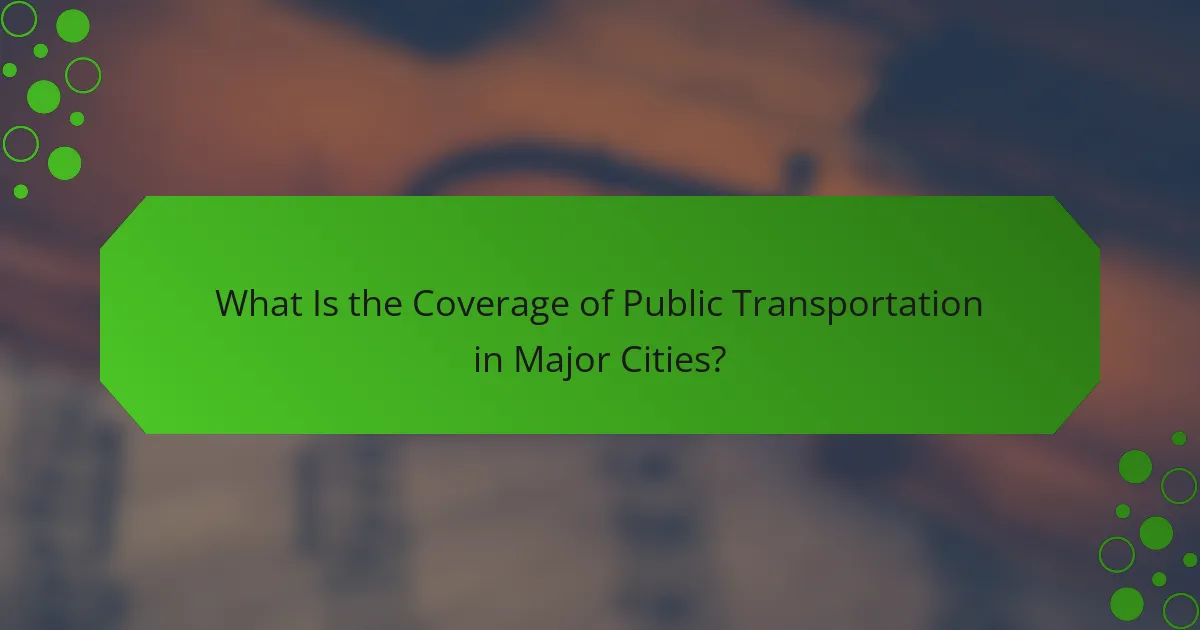
What Is the Coverage of Public Transportation in Major Cities?
The coverage of public transportation in major cities varies significantly, impacting accessibility for residents and visitors. Generally, urban areas offer extensive networks that include buses, trains, and trams, while suburban regions may have limited options.
City A coverage map
City A boasts a comprehensive public transportation network that covers nearly all urban neighborhoods. The system includes multiple bus lines and a light rail service, providing frequent connections to major employment centers and attractions.
Key routes operate every 10-15 minutes during peak hours, ensuring minimal wait times. Residents can access a detailed coverage map online, which highlights service areas and transfer points.
City B coverage map
City B’s public transportation coverage is extensive but varies by district. Central areas are well-served by buses and subways, while some outer neighborhoods may experience less frequent service.
To navigate the system effectively, users should consult the city’s interactive coverage map, which indicates service frequency and operational hours. Understanding peak times can help avoid overcrowding on popular routes.
City C coverage map
City C features a mixed public transportation system that includes buses, ferries, and a metro line. The coverage is designed to connect key residential areas with commercial hubs, but some regions may lack direct service.
Travelers can utilize the city’s online coverage map to identify routes and plan their journeys. It’s advisable to check for service alerts, especially during weekends or holidays, as schedules may change.

What Are the Criteria for Choosing Public Transportation?
When selecting public transportation, consider accessibility features, cost-effectiveness, and coverage area. These criteria help ensure that the chosen option meets your needs and provides a reliable travel experience.
Accessibility features
Accessibility features in public transportation are essential for individuals with disabilities or mobility challenges. Look for options that include wheelchair ramps, designated seating, and audio-visual announcements. Many systems also offer paratransit services for those who cannot use standard buses or trains.
Check local regulations, as many countries have laws mandating accessibility standards for public transport. For instance, in the European Union, public transport must comply with the Public Transport Accessibility Directive, ensuring that services are usable for all passengers.
Cost-effectiveness
Cost-effectiveness is a critical factor when evaluating public transportation options. Compare fares across different modes, such as buses, trains, and trams, to determine which offers the best value for your travel needs. Many cities provide discounted passes for frequent riders, students, or seniors, which can significantly reduce overall costs.
Consider additional expenses, such as parking fees or transfers, which can impact the total cost of your journey. Using public transport can often be cheaper than owning a car, especially when factoring in fuel, insurance, and maintenance costs.
Coverage area
The coverage area of public transportation determines how far you can travel and the frequency of service. Evaluate whether the routes connect key destinations like workplaces, schools, and shopping centers. A well-connected system will save you time and make commuting more convenient.
Research the hours of operation and the frequency of service, as these can vary significantly. Some areas may have limited service during off-peak hours, so it’s essential to plan your trips accordingly to avoid long wait times.
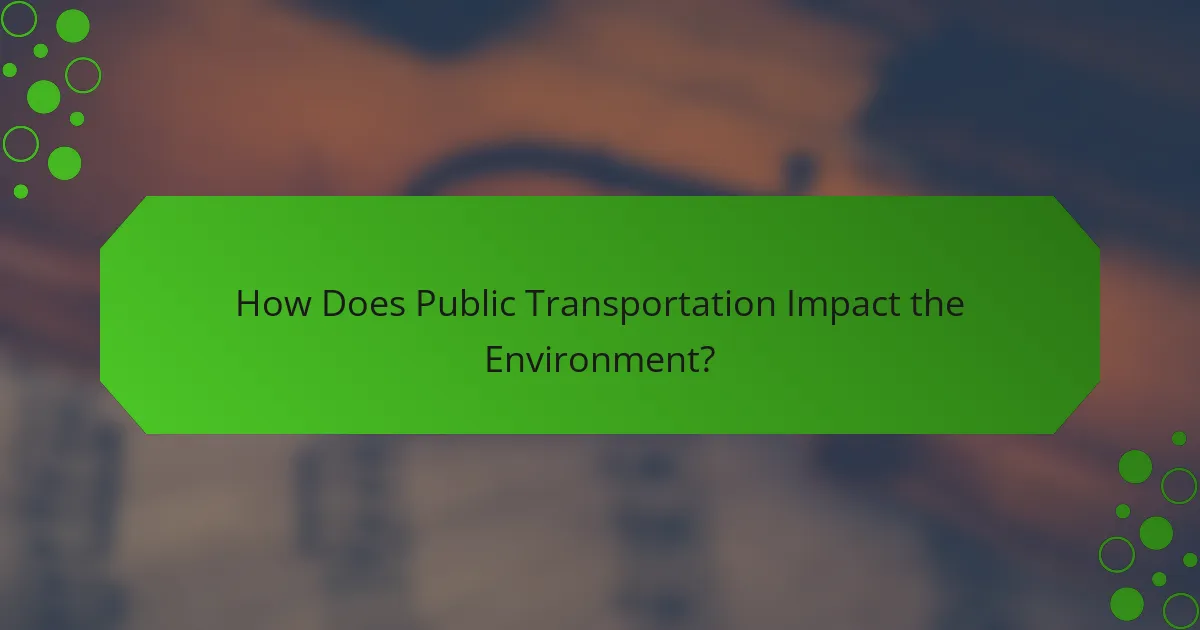
How Does Public Transportation Impact the Environment?
Public transportation significantly reduces environmental impact by lowering the number of individual vehicles on the road, which in turn decreases pollution and conserves energy. Efficient transit systems contribute to cleaner air and a smaller carbon footprint, making them a vital component of sustainable urban development.
Reduction in carbon emissions
Public transportation systems, such as buses and trains, emit considerably less carbon dioxide per passenger compared to private vehicles. For instance, a full bus can replace dozens of cars, leading to a substantial decrease in overall emissions. Studies suggest that using public transit can reduce individual carbon footprints by up to 45% in urban areas.
To maximize the benefits, cities should promote public transport usage through incentives like reduced fares or improved service frequency. Additionally, integrating electric or hybrid vehicles into public transit fleets can further enhance emission reductions.
Energy efficiency of public transit
Public transit is generally more energy-efficient than private car travel, consuming less fuel per passenger mile. Buses and trains can transport many people simultaneously, which spreads the energy cost across a larger number of riders. This efficiency can lead to energy savings of 30-50% compared to single-occupancy vehicles.
Investing in modern, energy-efficient transit technologies, such as electric buses or light rail systems, can further improve energy efficiency. Cities should consider upgrading their infrastructure to support these advancements, which not only helps the environment but can also reduce operational costs in the long run.
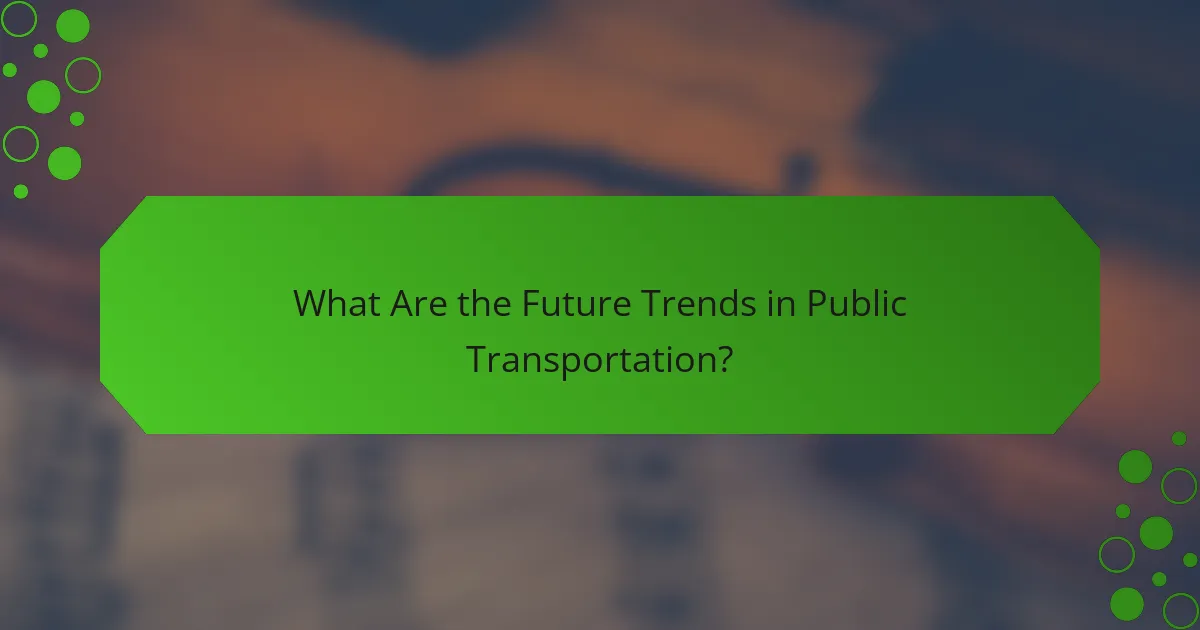
What Are the Future Trends in Public Transportation?
Future trends in public transportation focus on sustainability, technology integration, and enhanced user experience. Innovations such as electric vehicles, autonomous systems, and real-time data analytics are reshaping how transit systems operate and serve communities.
Increased Use of Electric and Autonomous Vehicles
The shift towards electric and autonomous vehicles is gaining momentum in public transportation. Many cities are investing in electric buses and trains to reduce emissions and improve air quality. Autonomous shuttles are being tested in various locations, promising to enhance efficiency and safety.
For instance, cities like Los Angeles and Amsterdam are expanding their electric bus fleets, aiming for significant reductions in greenhouse gas emissions. Autonomous vehicles could also lower operational costs and increase service frequency, making public transit more appealing.
Integration of Smart Technology
Smart technology is becoming integral to public transportation systems, enhancing user experience and operational efficiency. Mobile apps that provide real-time tracking, mobile ticketing, and personalized route planning are increasingly common.
For example, cities like Singapore and Barcelona utilize smart technology to streamline transit operations and improve rider convenience. These innovations help reduce wait times and make navigating public transport easier for users.
Focus on Accessibility and Inclusivity
Accessibility and inclusivity are becoming central to public transportation planning. Transit agencies are working to ensure that services cater to all individuals, including those with disabilities, the elderly, and low-income populations.
Efforts include designing more accessible vehicles, improving station facilities, and offering subsidized fares for low-income riders. Cities like New York and London have implemented programs to enhance accessibility, ensuring that public transport is a viable option for everyone.
